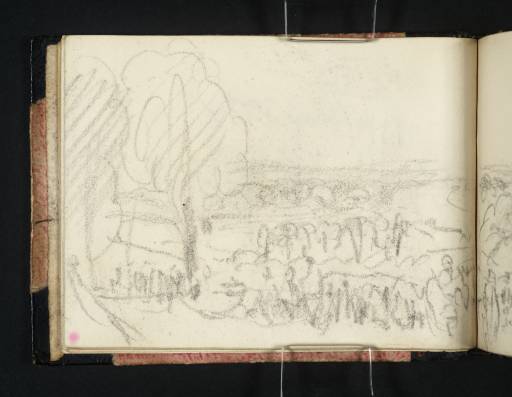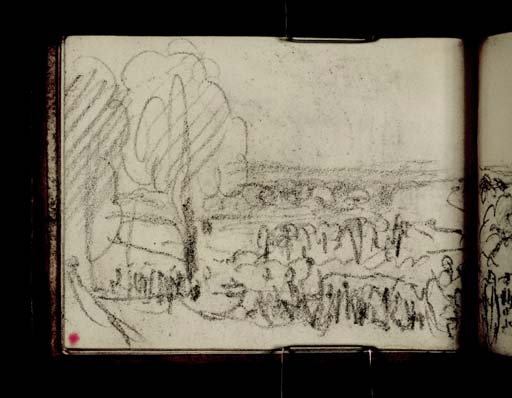Joseph Mallord William Turner Study for 'England: Richmond Hill, on the Prince Regent's Birthday' c.1815-18
Image 1 of 2
Joseph Mallord William Turner,
Study for 'England: Richmond Hill, on the Prince Regent's Birthday'
c.1815-18
Joseph Mallord William Turner 1775–1851
Folio 10 Verso:
Study for ‘England: Richmond Hill, on the Prince Regent’s Birthday’ circa 1815–18
D10601
Turner Bequest CXLI 10a
Turner Bequest CXLI 10a
Pencil on white wove paper, 88 x 114 mm
Accepted by the nation as part of the Turner Bequest 1856
References
1909
A.J. Finberg, A Complete Inventory of the Drawings of the Turner Bequest, London 1909, vol.I, p.405, CXL 10a, as ‘The Terrace, Richmond Hill’.
1974
Gerald Wilkinson, The Sketches of Turner, R.A. 1802–20; Genius of the Romantic, London 1974, p.174 reproduced.
1974
Martin Butlin, Andrew Wilton and John Gage, Turner 1775–1851, exhibition catalogue, Royal Academy, London 1974, p.78.
1983
John Gage, in Gage, Jerrold Ziff, Nicholas Alfrey and others, J.M.W. Turner, à l’occasion du cinquantième anniversaire du British Council, exhibition catalogue, Galeries nationales du Grand Palais, Paris 1983, p.99.
1984
Martin Butlin and Evelyn Joll, The Paintings of J.M.W. Turner, revised ed., New Haven and London 1984, p.106.
2001
Martin Butlin, ‘England: Richmond Hill, on the Prince Regent’s Birthday’, in Evelyn Joll, Martin Butlin and Luke Herrmann eds., The Oxford Companion to J.M.W. Turner, Oxford 2001, p.89.
Continued on folio 11 of the sketchbook (D10602) this is a study for England: Richmond Hill, on the Prince Regent’s Birthday (Tate N00502)1 exhibited at the Royal Academy in 1819. Two variant double-spread studies follow on folios 11 verso–13 (D10603–D10606). Although described by Butlin and Joll as ‘drawings of the general view from Richmond Hill’ they are surely directly preparatory for the picture as they place so much emphasis on a crowd of figures and, in the continuation of the present study on D10602, the drum which Turner painted just to right of centre can be clearly seen. Also related to Turner’s plans for the picture is the copy on folios 26 verso–27 (D10629–D10630) after Antoine Watteau’s Enchanted Isle (private collection) in the collection of his friend, the artist James Holworthy. Watteau’s picture had formerly belonged to the painter Sir Joshua Reynolds and Turner must have taken it into account not only because it depicted an elegant garden party, but because Reynolds’s former home at Wick House commanded much the same view of Richmond Hill as he intended to paint in his own picture. A number of drawings in the contemporary Richmond Hill; Hastings to Margate sketchbook (Tate D10409–D10585; D40868; D41539; Turner Bequest CXL) must also have been used for it.
Turner’s largest exhibited canvas so far, England; Richmond Hill has complex origins and motivations beyond the wish to depict a famous prospect. The exhibition of T.C. Hofland’s similarly enormous View from Richmond Hill (formerly at the Grocers’ Hall, London; destroyed) at the Royal Academy in 1815 was one spur, but so was Thomas Stothard’s more modest Sans Souci (Tate N01829), the first of a number of popular pastiches of Watteau by this artist, shown at the Academy in 1817. Martin Butlin has noted similarities of format, details and royal associations with Philip IV of Spain Hunting Boar (La Tela Real) (National Gallery, London) by Diego Velázquez (1599–1660) which was lent by Sir Henry Wellesley to the British Institution in 1819,2 but as its exhibition more or less coincided with the Academy’s these can only be coincidental. In the context of Turner’s own work, the picture follows earlier canvases like Thomson’s Aeolian Harp (Manchester Art Gallery)3 in associating English scenery and poetry; it was exhibited with verses from James Thomson’s Seasons describing sights visible from Richmond Hill. It also alluded indirectly to Shakespeare as the Prince Regent’s official birthday was often celebrated on 23 April, traditionally Shakespeare’s birthday, Turner’s and St George’s Day as well.
The actual event depicted is still unclear, and may be compounded from various Richmond fêtes, press reports or hearsay with Turner’s characteristic artistic licence. Charles Stuckey has pointed out that the Regent rode up to Richmond Hill from Kew Palace on 10 August 1818, two days before his actual birthday,4 and as has been widely observed, Turner’s picture shows an August rather than an April afternoon; Stuckey also noted that the Regent was in London when his official birthday was celebrated on 23 April that year. Subsequently Jean Golt identified Turner’s subject with a party held for the Prince by Lady Cardigan at her house at Richmond on 12 August 1817,5 which received detailed press coverage.6 However, the fact remains that, as Golt also acknowledged, Turner had already left for a continental tour while Cardigan House (demolished in 1971) stood at the bottom of the hill, on the riverside, not at the top as painted by Turner.
England: Richmond Hill was Turner’s most ambitious attempt so far to attract royal patronage, the Regent having failed to buy Mercury and Herse (on the London art market in 2005)7 from the Royal Academy in 1811 despite having apparently praised it in his speech at the Academy dinner. As a final Watteauesque stimulus, the Regent lent a pair of pictures attributed to Watteau (but actually by Jean-Baptiste Pater) to the British Institution in 1818. In the event the picture did not sell at all, being shown again at Turner’s Gallery in 1835 and becoming a focal point in its later displays, when it hung on an end wall.
David Blayney Brown
July 2011
How to cite
David Blayney Brown, ‘Study for ‘England: Richmond Hill, on the Prince Regent’s Birthday’ c.1815–18 by Joseph Mallord William Turner’, catalogue entry, July 2011, in David Blayney Brown (ed.), J.M.W. Turner: Sketchbooks, Drawings and Watercolours, Tate Research Publication, December 2012, https://www


